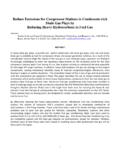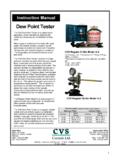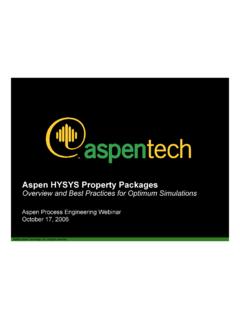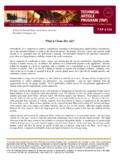Transcription of Membrane Fuel Gas Conditioning - Membrane technology
1 REPRINTED FROM hydrocarbon ENGINEERING MAY 2000 During the last 15 years,gas separation withpolymer membraneshas become an important sep-aration technology . In the nat-ural gas industry, the principalapplication of membranes hasbeen the separation of carbondioxide from natural gas. Over200 systems have alreadybeen installed, with some unitsprocessing in excess of 100 MMSCFD. The membranesused in the CO2removal appli-cation are made from rigid,glassy polymers. MembraneTechnology & Research, Inc.(MTR) has developed andcommercialised a new mem-brane based process calledVaporSep . The enabling tech-nology of VaporSep is a rub-bery Membrane , which hasunique separation Membrane permeatescondensable vapours, such asC3+ hydrocarbons, aromatics,and water vapour, while reject-ing non-condensable gases,such as methane, ethane,nitrogen and based on these membranes were first commer-cialised in 1990.
2 Since then, MTR has supplied more than50 systems to the chemical process industry majority of these units are found in the polymer indus-try in the production of polyvinyl chloride (PVC), polyethyl-ene (PE), and polypropylene (PP). These unique rubbery membranes have recently beenapplied to the separation of C3+ hydrocarbons frommethane and ethane in natural gas processing. One of theapplications for the technology is to condition fuel gas usedin gas engines and turbines in the natural gas industry. Adetailed description of the application and the benefits ofthe Membrane system are discussed separationPolymer membranes separate components of a gas mix-ture because the components permeate the Membrane atdifferent rates. In all Membrane separations, the drivingforce is the difference in pressure between the feed and thepermeate side of the Membrane .
3 In rigid, glassy polymers,the dominant factor determining Membrane selectivity isthe ratio of the gas diffusion coefficients, which is highlydependent on molecular size. Thus, glassy polymer mem-branes typically permeate the smaller molecules, methaneand ethane, and reject the larger molecules, propane,butane, and higher hydrocarbons. In rubbery polymermembranes, the dominant factor determining membraneselectivity is the ratio of the gas solubilities, which reflectsthe ratio of the condensability of the components. Thus,rubbery polymer membranes preferentially permeate thelarger, more condensable molecules such as propane,butane, and higher hydrocarbons and reject methane andethane at pressure as the residue. This behaviour iscounter-intuitive since any normal filter will allow the small-er molecules to pass through and retain the physically larg-er molecules.
4 This reverse selective behaviour has beenutilised by MTR to design commercially successful systemsfor various gas for fuelgas conditioningKaaeid A. Lokhandwala and Marc L. Jacobs, Membrane technology &Research, Inc., USA, discuss the use of Membrane technology for conditioningfuel gas for use in gas engines and turbines in the natural gas 1. Membrane cross 2. Spiral wound 17/6/03 9:03 Page 81 The Membrane , shown in Figure 1, consists of threelayers; a non-woven fabric which serves as the membranesubstrate; a tough, durable, and solvent-resistant microp-orous support layer which provides mechanical supportwithout mass transfer resistance, and a dense, defect free,rubbery layer which performs the manufacture as flat sheets, the Membrane is pack-aged into a spiral-wound module as shown in Figure 2.
5 Thefeed gas enters the module and flows between the mem-brane sheets. Spacers are added on the feed and permeateside to create flow channels. As the hydrocarbon preferen-tially permeates through the Membrane , the gas spiralsinward to a central collection pipe. Methane and other lightgases are rejected and exit as the residue stream. Themembrane modules are placed into pressure vessels andconfigured in series and parallel flow combinations to meetthe requirements of a particular membranes can be incorporated into systems inseveral different ways. Many sys-tems have the basic design shownin Figure 3. The feed gas is firstcompressed and sent to a con-denser where it is cooled. A portionof the heavy hydrocarbon fractioncondenses and is recovered as aliquid.
6 The non-condensed portionof the gas, which still contains asignificant fraction of the heavyhydrocarbon components, passesacross the surface of the mem-brane. The Membrane separatesthe gas into two streams: a perme-ate stream enriched in heavy hydro-carbons and a residue streamwhich is depleted of heavy hydro-carbons. The permeate stream isrecycled to the compressor inletwhile the residue stream (which ismaintained at pressure) is the treat-ed natural gas stream. Gas engine applicationNatural gas is commonly used as afuel in gas engines and turbines inthe hydrocarbon processing , raw natural gas is theonly fuel available to operate com-pressor stations in remote locationsand on offshore platforms. This gashas a high heating value, high hydrocarbon dew point, andlow octane number, which can cause operating gas engines, the rich fuel may pre-detonate which canseverely damage the internals of the firing chamber.
7 Inaddition, condensation of hydrocarbons (due to day-nighttemperature variations) may damage the combustionchambers in gas engines and gas turbines, increasingmaintenance costs and downtime. Since the engines andturbines drive other machinery, any disruption in their oper-ation will reduce production resulting in significant revenueloss. fuel gas Conditioning is particularly important for gasturbines on offshore platforms, where this equipment is theonly source of power. To increase the reliability and reduceunscheduled downtime of such key equipment, a simpletechnology that conditions fuel gas is diagram of the Membrane to condition raw nat-ural gas is shown in Figure 4. The gas, at a pressure of100 psig, is compressed to 1000 psig and cooled in an air-REPRINTED FROM hydrocarbon ENGINEERING MAY 2000 CompressorUntreatednatural gasLiquid HCMembraneTreatednaturalgasCondenserPerm eateResidue CompressorVaporSep systemCompressednatural gasConditionedfuel gasPermeateGas engineor turbineDriveshaftMembraneMembraneFuel gascompressorPermeateRaw fuelgasVaporSep systemNGL liquidsConditionedfuel gasFigure 3.
8 Flow scheme for natural as 4. fuel gas Conditioning for gas 5. fuel gas Conditioning for gas 17/6/03 9:03 Page 82cooled aftercooler. The heavy hydrocarbons are con-densed and recovered as a liquid. The high-pressure gas,saturated in heavy hydrocarbons, contains of C4+hydrocarbons and over 5000 ppm hydrogen sulfide. Thisgas is not an ideal engine fuel . To improve the gas quali-ty, the pressurised fuel stream is sent to the membranesystem which reduces the total C4+ hydrocarbon contentto and removes about 80% of the hydrogen treated gas is then routed to the gas engine as heavy hydrocarbon rich permeate stream is sent tothe feed side of the compressor. The fuel conditioningsystem is completely passive. The power to drive the sep-aration is provided by the existing compressor, sothat no new rotating equipment is required.
9 In addi-tion, the Conditioning occurs at ambient temperature,avoiding the issues of hydrate formation. The com-position and conditions for the feed and conditionedgas are given in Table conditioned fuel gas is significantly depletedin the higher hydrocarbons. The hydrocarbon dewpoint of the gas is reduced from 35 to 4 C. The mem-brane system selectively removes the hydrocarbonsthat cause knocking while retaining those that con-tribute to the heating value of the gas. At the sametime, the system completely dehydrates the fuel system is skid-mounted and is approximately 5 ftlong by 5 ft wide by 8 ft high. No operator attention isrequired and since the system has no moving part,maintenance expenses are minimal. The expectedmembrane life is from 3 to 5 turbine applicationGas turbines are used increasingly in the gas pro-cessing industry especially as compression driversand for power generation on offshore platforms andremote locations.
10 The turbines are frequently pow-ered by raw, associated gas produced with the raw gas is typically rich in condensable hydro-carbons and at low pressure. Figure 5 shows aprocess flow diagram of a fuel Conditioning system for gasturbine. The fuel is compressed in a screw compressorfrom 35 to 285 psig. The gas is then cooled, partially con-densing the heavier hydrocarbons, which are removedfrom the gas in a separator. Since the gas from the sepa-rator is fully saturated, condensation may occur in the fuelline to the turbine. Moreover, this gas is very rich in hydro-carbons and may not meet the fuel specifications of theturbine manufacturer. Rich fuel tends to burn less effi-ciently in the combustors, leading to carbon formation,which fouls and damages the turbine blades.











